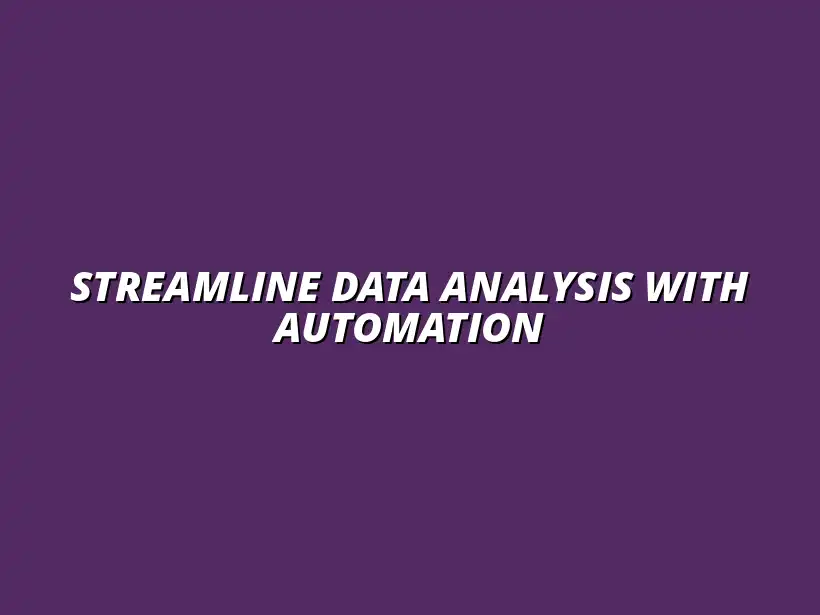
Streamline Data Analysis with Automation
Understanding the Basics of Google Sheets Automation for Data Analysis
Google Sheets automation is a powerful way to simplify and speed up data analysis tasks. With automation, you can set up processes that run on their own, which saves time and reduces human error. This means you can focus more on interpreting the data rather than just gathering it!
By automating repetitive tasks in Google Sheets, such as data entry and calculations, you can enhance your productivity significantly. Understanding how to use automation effectively can lead to better insights and more informed decision-making in your projects. To learn more about automating tasks using Google Sheets, check out this helpful resource: Automate Tasks Using Google Sheets.
Defining Google Sheets Automation and Its Importance
What is Google Sheets Automation?
Google Sheets automation refers to using advanced features and tools within Google Sheets to perform tasks automatically. This includes using built-in functions, macros, and scripts to handle various data-related activities. Essentially, automation allows you to streamline your workflow and make data handling easier!
Whether you're collecting data, performing analyses, or generating reports, automation in Google Sheets makes these tasks faster and less prone to mistakes. It's like having a smart assistant that takes care of the mundane aspects of data work for you!
The Role of Automation in Data Analysis
Automation plays a critical role in data analysis by improving accuracy and efficiency. When tasks are automated, the risk of human error is minimized, leading to more reliable outcomes. For instance, functions like SUM, AVERAGE, and VLOOKUP can automatically calculate and retrieve data, leaving you to analyze the results.
Moreover, automation helps in managing large datasets. For example, you can set up scripts to update and sort data based on specific criteria automatically. This capability allows you to focus on deeper insights rather than getting bogged down by manual processes! Effective data visualization is also key; learn more about effective data visualization in Google Sheets.
Key Features of Google Sheets That Facilitate Automation
Built-in Functions and Formulas for Streamlined Analysis
Google Sheets comes with a variety of built-in functions and formulas that make automation seamless. Some key functions include:
- SUM - Adds up a range of cells.
- AVERAGE - Calculates the average of a set of values.
- COUNTIF - Counts cells that meet a specific condition.
- INDEX/MATCH - Retrieves data dynamically based on criteria.
Using these functions can greatly enhance your analysis capabilities. They allow you to automate calculations and data retrieval without much hassle, making your workflow much smoother!
Google Apps Script: Custom Automation Solutions
For those looking to take their automation to the next level, Google Apps Script is a fantastic tool. This powerful scripting language allows you to customize and create your own automation solutions tailored to your specific needs. With Apps Script, you can automate tasks such as sending emails, generating reports, and even integrating with other web services. Learn how to automate tasks with Google Sheets scripts to streamline your workflow.
Some examples of what you can achieve with Google Apps Script include:
- Automating email notifications based on data changes.
- Creating custom functions that suit particular data analysis needs.
- Integrating Google Sheets with external data sources.
By leveraging Google Apps Script, you can unlock endless possibilities for optimizing your data handling processes!
Addressing Frequently Asked Questions About Google Sheets Automation
What Types of Data Analysis Can Be Automated Using Google Sheets?
Examples of Common Analytical Tasks for Automation
Google Sheets is an amazing tool for automating various types of data analysis. From simple calculations to more complex data manipulations, you can streamline numerous tasks that would otherwise consume a lot of time. Here are some common analytical tasks that can benefit from automation:
- Data Cleaning: Removing duplicates or blank rows automatically.
- Statistical Analysis: Running mean, median, or mode calculations on datasets.
- Trend Analysis: Identifying patterns over time using automated formulas.
- Reporting: Generating periodic reports with updated figures without manual input. Easily automate Google Sheets reports to save time and effort.
Limitations and Considerations When Automating Data Analysis
While Google Sheets automation can boost efficiency, there are some limitations to keep in mind. For instance, the size of data sets is crucial, as Google Sheets handles fewer rows than databases. Additionally, you might encounter challenges with advanced analytical tasks that require specialized software.
Other considerations include the need for clear data structure and understanding the limits of built-in functions. It's essential to plan your automation wisely to avoid any mishaps.
How to Get Started with Google Sheets Automation
Step-by-Step Guide to Setting Up Your First Automated Workflow
Getting started with Google Sheets automation is easier than you might think! Here’s a simple step-by-step guide to kick off your first automated workflow:
- Identify the Task: Choose a repetitive data analysis task that you want to automate.
- Explore Functions: Look for built-in functions that can help, such as SUM or AVERAGE.
- Set Up Google Apps Script: Open the Script Editor through Extensions and write a simple script for your task.
- Test the Automation: Run your script to see if it performs as expected.
Resources and Tools for Learning Google Sheets Automation
If you're eager to learn more about Google Sheets automation, there are numerous resources available. Online tutorials and courses can help solidify your understanding and skills. Here are some excellent places to start: Google Sheets Data Visualization Tips.
- Google’s Official Documentation: A comprehensive guide on using Google Sheets.
- YouTube Tutorials: Visual learners can find helpful videos explaining the automation process.
- Online Courses: Websites like Coursera or Udemy offer structured learning paths.
Final Thoughts on Streamlining Data Analysis with Google Sheets Automation
Future Trends in Data Analysis Automation
Emerging Technologies that Impact Data Analysis
As technology evolves, so do the features of Google Sheets. Automation is becoming increasingly sophisticated, with machine learning and AI likely to enhance data analysis further. It's exciting to think about how these advancements will make our workflows even smoother!
Staying informed about emerging technologies will help you adapt and adopt new tools that can enhance your automation efforts. Learn how to automate tasks with Google Sheets and improve your efficiency.
Preparing for Changes in Data Management Practices
Being proactive about changes in data management practices is essential. Understanding the integration of automation with other tools will prepare you for future developments. Whether it’s embracing new add-ons or keeping an eye on updates, staying ahead will pay off! You can also streamline your Google Sheets tasks for better productivity.
Encouraging Engagement and Continuous Learning
Inviting Readers to Share Their Experiences with Google Sheets Automation
I encourage my readers to share their own experiences with Google Sheets automation! Hearing about your challenges and successes can foster a community of learning. Don’t hesitate to drop a comment or connect on social media!
Promoting Further Learning Opportunities and Resources
Lastly, I recommend continually seeking out new learning opportunities. As automation tools and techniques evolve, staying curious and engaged will help you make the most of Google Sheets. Let’s keep exploring and growing together in this exciting field!




